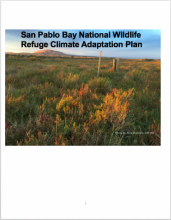San Pablo Bay National Wildlife Refuge Climate Adaptation Plan

Future climate change is expected to cause dramatic changes in the physical and biological environment of the San Pablo Bay National Wildlife Refuge (Refuge). To effectively plan for an uncertain future, managers and decision makers must consider a range of future scenarios using tools and decision support frameworks that can incorporate uncertainty. Successful strategies will be those that are robust to uncertainty and are likely to provide benefits across a range of scenarios. Uncertain future conditions may also require managers to re-assess traditional conservation goals as they may no longer be feasible under novel conditions.
The purpose of this climate adaptation project is to use the best available information to (1) identify a suite of actions with the highest likelihood of achieving Refuge goals that are feasible and contribute to larger landscape conservation (e.g., USFWS Tidal marsh Recovery Plan 2013); (2) gain a better understanding of the projected impacts of climate change on refuge conservation targets; and (3) identify the suite of measures needed to assess conservation progress and support an adaptive decision-making framework.
A working group comprising the San Francisco Bay Joint Venture, Refuge staff, and local scientific experts used the Open Standards for the Practice of Conservation (2013) and structured decision making tools to identify strategies aimed at achieving the Refuge’s natural resource conservation vision in light of climate change uncertainty and other environmental threats. The working group first identified Refuge conservation targets and associated key ecological attributes and indicators. We then used conceptual models, expert opinion, and the best available scientific information to identify the most critical threats to Refuge conservation targets from climate change (such as drought, extreme storms, sea level rise) and other threats in two time periods, near term (2016 – 2030) and long term (2030 – 2100). The highest ranked threats in the near- and long-term were climate change, land conversion, and invasive plants. We then brainstormed and ranked strategies (N = 39) aimed at reducing the stress caused by the most critical threats.
The following strategies were ranked as the highest priority in the near term:
• Invasive plant management
• Land acquisition
• Raise Hwy 37 from Petaluma River to Mare Island
• Improve Tolay Creek tidal connection across Hwy 37
The following strategies were ranked as the highest priority in the long term:
• Land acquisition
• Invasive plant management
• Move refuge boundaries upland
• Raise Hwy 37 from the Petaluma River to Mare Island
• Tidal marsh restoration at Skaggs Island
Refuge staff will ensure that near term activities do not prevent long term strategies from being implemented and will look for opportunities to begin implementing long term strategies.
The decision making process was collaborative and transparent enabling the working group to develop agreed upon priority management strategies. The process enabled scientific experts and refuge staff to coproduce the strategies ensuing collective support as strategies move forward towards implementation. This climate adaptation plan can be used to focus scientific inquiry and direct external decision making and natural resource management to help achieve refuge goals.
Veloz, S., J. Wood, D. Jongsomjit, G. Block, and K. F. Robinson. 2016. San Pablo Bay National Wildlife Refuge Climate Adaptation Plan. USFW National Wildlife Refuge System, Petaluma, CA.
